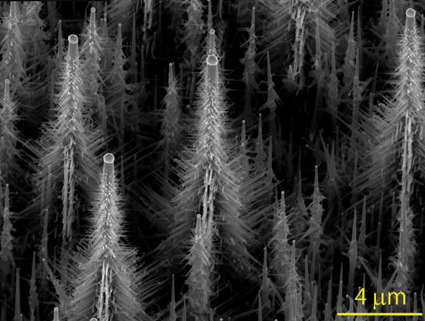With this technology, components capable of delivering a surge of power within a few seconds could be introduced in silicon chips, thus improving the power and speed of microelectronic circuits.
A supercapacitor allows electrical energy storage by accumulating ions on the surface of its electrodes. In addition to its electrical qualities of low resistance and high capacity, a quasi-ideal electrode should have a surface as large as possible at the level of ions, and its properties must remain stable in the presence of the electrolyte. The choice of nanowires or silicon nanotrees on a substrate made of the same material meets these specifications, with doping and a special surface treatment. Such electrodes, made in our laboratory, have been successfully tested in various configurations at the Institut des matériaux in Nantes. Within a supercapacitor architecture, they have been associated with two types of electrolytes: ionic liquids (molten salts at room temperature) and gels of ionic liquids. Trials have specifically included repeated cycles and highlighted a quasi-ideal behavior of these devices, as well as its stability over time.
Within a few months, this research will continue as part of a European project aimed at providing additional features for silicon nanowires. With an extended storage capacity, supercapacitors -now called "pseudo-supercapacitors"- could exhibit performance ten times higher than previous levels and thus meet new needs in terms of energy storage.
